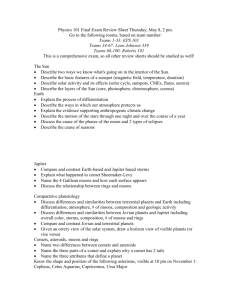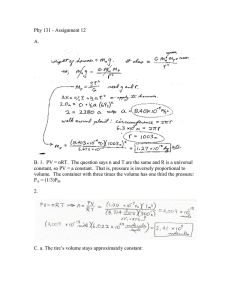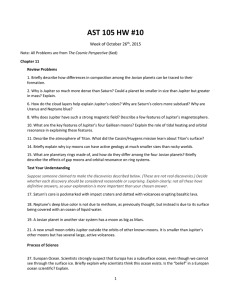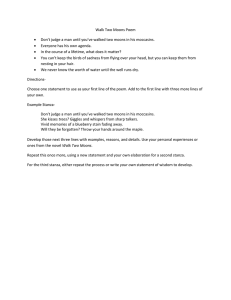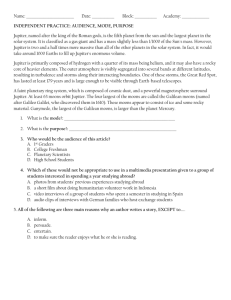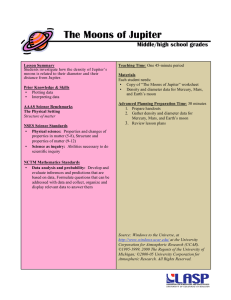Jupiter's Moons Analysis
advertisement
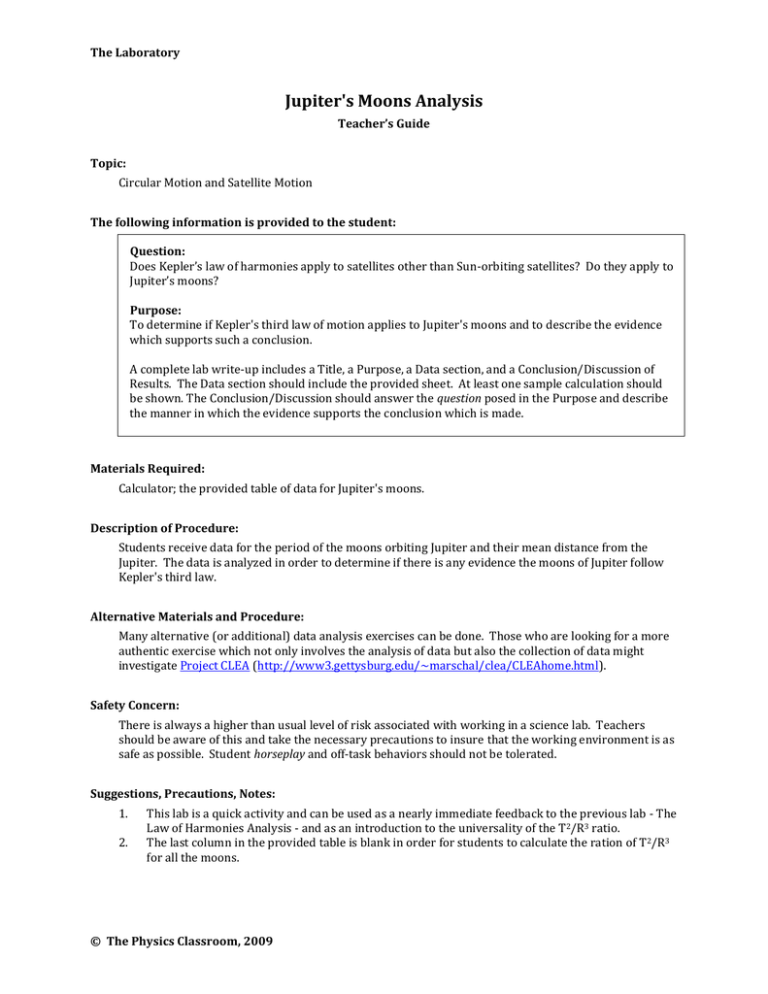
The Laboratory Jupiter's Moons Analysis Teacher’s Guide Topic: Circular Motion and Satellite Motion The following information is provided to the student: Question: Does Kepler’s law of harmonies apply to satellites other than Sun-orbiting satellites? Do they apply to Jupiter’s moons? Purpose: To determine if Kepler's third law of motion applies to Jupiter's moons and to describe the evidence which supports such a conclusion. A complete lab write-up includes a Title, a Purpose, a Data section, and a Conclusion/Discussion of Results. The Data section should include the provided sheet. At least one sample calculation should be shown. The Conclusion/Discussion should answer the question posed in the Purpose and describe the manner in which the evidence supports the conclusion which is made. Materials Required: Calculator; the provided table of data for Jupiter's moons. Description of Procedure: Students receive data for the period of the moons orbiting Jupiter and their mean distance from the Jupiter. The data is analyzed in order to determine if there is any evidence the moons of Jupiter follow Kepler's third law. Alternative Materials and Procedure: Many alternative (or additional) data analysis exercises can be done. Those who are looking for a more authentic exercise which not only involves the analysis of data but also the collection of data might investigate Project CLEA (http://www3.gettysburg.edu/~marschal/clea/CLEAhome.html). Safety Concern: There is always a higher than usual level of risk associated with working in a science lab. Teachers should be aware of this and take the necessary precautions to insure that the working environment is as safe as possible. Student horseplay and off-task behaviors should not be tolerated. Suggestions, Precautions, Notes: 1. 2. This lab is a quick activity and can be used as a nearly immediate feedback to the previous lab - The Law of Harmonies Analysis - and as an introduction to the universality of the T2/R3 ratio. The last column in the provided table is blank in order for students to calculate the ration of T 2/R3 for all the moons. © The Physics Classroom, 2009 The Laboratory 3. The data is provided for four of Jupiter's known 63 moons. They are the largest four of its moons, being discovered by Galileo in 1610. Orbital data for the other moons is readily available online. For instance, see Wikipedia's Jupiter's Moons. Auxiliary Materials: The following page is provided to the student for completion and inclusion in the Data section of their lab notebook. Jupiter's Moon Period (sec) Radius of Orbit (m) Io 1.53 x 105 4.2 x 108 Europa 3.07 x 105 6.7 x 108 Ganymede 6.18 x 105 1.1 x 109 Callisto 1.44 x 106 1.9 x 109 Scoring Rubric: CG8. Jupiter’s Moons Analysis Included, labeled and organized all parts of the lab report. Data section includes the provided table with the last column completed; units are indicated; at least one sample calculation is clearly shown and labeled. Conclusion/Discussion answers the question posed in the Purpose and describes the supporting evidence. Score _____/_____ Connections to The Physics Classroom Tutorial: The following reading is a suitable accompaniment to this lab: http://www.physicsclassroom.com/Class/circles/u6l4a.cfm Connections to Minds on Physics Internet Modules: Sublevel 10 of the Circular and Satellite Motion module is a suitable accompaniment to this lab: http://www.physicsclassroom.com/mop/module.cfm © The Physics Classroom, 2009

